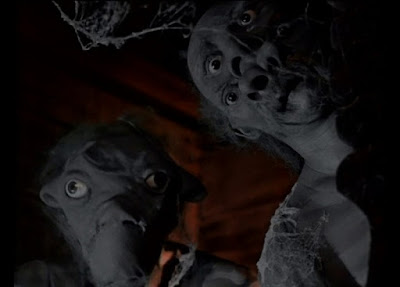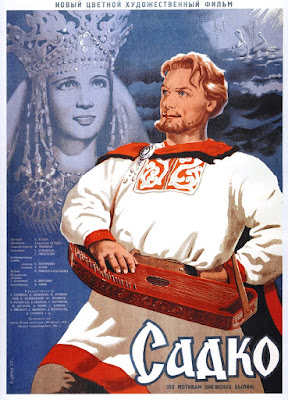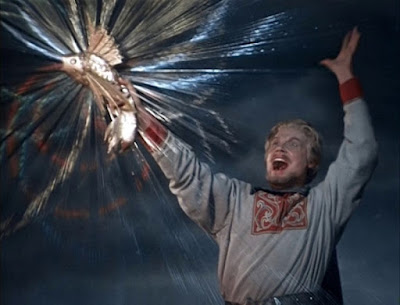(1967) Directed by: Konstantin Ershov and Georgiy Kropachyov; Written by Konstantin Ershov, Georgiy Kropachyov and Aleksandr Ptushko; Based on the story by Nikolay Gogol; Starring: Leonid Kuravlyov, Natalya Varley, Aleksey Glazyrin, Vadim Zakharchenko and Pyotr Vesklyarov; Available on Blu-ray, DVD and Shudder
Rating: ****
“A curse upon you! With the wings of a bat! With the blood
of a serpent! I shall curse you!”
– Pannochka (Natalya Varley)
Note: The following review is an expanded version of a capsule review from December 2016.
Although fantasy and science fiction films enjoyed their
place in the former Soviet Union, the horror genre didn’t fare nearly as well. Viy
(aka: Viy or Spirit of Evil) is often touted as the “first”
Soviet-era horror film (admittedly, what does and doesn’t constitute horror is
up for debate), and in the absence of other salient examples, it’s difficult to
dispute this claim. While it’s clear that subjects of a supernatural bias were
discouraged, I’m not quite ready to accept that this was the only horror movie
to be released between 1922 and 1967. Nevertheless, evidence to the contrary has
yet to surface. Viy was based on an 1835 short story by noted Ukrainian
author Nikolai Gogol. The original novella professes to be derived from
Ukrainian folklore, but whether or not it was entirely concocted by Gogol
remains open for debate.
In the opening scene, set in a Kiev-based seminary, the
stern rector dismisses his students for a holiday break. Khoma (Leonid
Kuravlyov) and two of his fellow students promptly take to the countryside for some
fun and mischief (much to the chagrin of their schoolmaster). Before long,
tired and weary from their travels, they seek shelter at in a farmhouse owned by
a withered old woman (Nikolay Kutuzov). She reluctantly puts them up for the
night, insisting that Khoma sleep in the stable. Things take a bizarre turn
when she singles him out, hopping upon his shoulders and revealing her true
nature as a witch. After soaring over the fields, they return to earth. He
beats her with a stick, leaving her for dead, but a second glance reveals not
an old crone, but a young woman. Puzzled and disturbed, Khoma returns to the
rectory, only to learn that the headmaster has received an unusual request – he
alone must hold a three-day prayer vigil for a wealthy Cossack’s recently
deceased daughter, Pannochka. Now, Khoma and the witch are inextricably
entwined.
Leonid Kuravlyov is a hoot in his manically comic performance as our perpetually bewildered protagonist, Khoma.* Far from the most diligent student at his rectory, he’s more concerned with food, drink and revelry than spiritual enlightenment. He tries to do everything he can to weasel out of his obligation to the Cossack patriarch, but the promise of a thousand gold pieces or a thousand lashes (if he disobeys) sways his decision. Each successive day of the vigil takes its toll on Khoma, while he’s locked away in the chapel, repeating his mantra, “A Cossack is never afraid of anything.” Meanwhile, his mental and physical state continue to erode as he endeavors to keep the evil spirits at bay and contend with a corpse that refuses to remain still.
* Khoma’s tentative demeanor reminded me of another literary
character, Ichabod Crane. Although I’m not sure if Gogol was aware of
Washington Irving’s story (published in 1820), its main character could be a
spiritual predecessor.
All eyes are on Natalya Varley as the not-so-deceased, Pannochka.
With her long dark hair and pallid complexion, she resembles the Iron Curtain’s
answer to Luna (from Mark of the Vampire) or Morticia Addams. She speaks
very few lines, but makes them sting, proving, hell hath no fury like a witch
scorned. Varley takes charge in every scene she’s in, dominating the scenery with
her frenzied, hypnotic stare.
The visuals of Viy benefited greatly through the
efforts of fantasy filmmaker Aleksandr Ptushko (Sadko, Ilya Muromets),
who provided the art direction and effects. Gogol’s story was vague in the
details about Khoma’s climactic confrontation with evil. The filmmakers,
however, gleefully fill in the blanks, delivering some genuinely unnerving moments
when the forces of darkness are unleashed in the chapel. It’s a dazzling
display, brought to life through dynamic, swirling POV shots, as all manner of things
that go bump in the night descend upon poor Khoma. Demons scuttle down the
walls and skeletons dance about, culminating in the appearance of Viy, a stocky
demon with giant eyelids, concealing a gaze that can kill. The final, visually
dense sequence, is a treat for the eyes, providing more than can be taken in
with one viewing.
Viy enchants and entertains, with its tantalizing mixture of comedy and the macabre. This faithful adaptation of Gogol’s story must have been a tough sell for the staid sensibilities of the prevailing regime, but it’s a testament to the persistence of Ptushko and co-directors Konstantin Ershov and Georgiy Kropachyov that their vision made it to Soviet theaters. Whether it was truly the first horror film or not, Viy remains an important landmark in Russian cinematic history, when films of the uncanny were such a scarce commodity. Its robust imagery and themes make it a force to be reckoned with, and no discerning fan of horror should consider his or her education complete without giving this a look.













